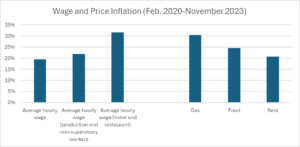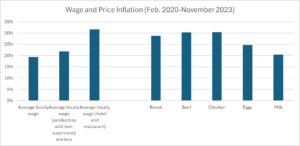Article • Dean Baker’s Beat the Press
Fact-based, data-driven research and analysis to advance democratic debate on vital issues shaping people’s lives.
Center for Economic and Policy Research
1611 Connecticut Ave. NW
Suite 400
Washington, DC 20009
Tel: 202-293-5380
Fax: 202-588-1356
https://cepr.net
Since President Biden took office, the media have run a constant stream of news stories about how high various prices were and telling their audiences that this has led to mass suffering. These stories appear less frequently now, although we still hear Republican politicians and people posting on social media that they are paying $5 for a gallon of gas or $90 for a turkey.
It is impossible to know what specific people pay for an item. Who knows, some stores charge outrageous prices and maybe people purchased a specialty item rather than the standard fare version.
But, it’s not worth spending time on the anomalies. We do have good data on the averages from the Bureau of Labor Statistics (BLS), which puts a great deal of effort into tracking prices and rents around the country. I thought it would be worth just posting some of the price increases on key items since the pandemic and comparing them with wage increases for various groups of workers.

Source: Bureau of Labor Statistics and author’s calculations.
The graph above shows the increase in the average hourly wage since February of 2020 for all workers, for production and non-supervisory workers, and for production and non-supervisory workers in the hotel and restaurant industries. The average hourly wage for all workers increased 19.4 percent, for production and non-supervisory workers it increased 21.9 percent, and for workers in the hotel and restaurant industry it increased 31.6 percent.
There are a couple of points worth making here before comparing these increases to the price increases over this period. First, the 19.4 percent increase for all workers is a hair more than the 18.8 percent rise in the overall Consumer Price Index over this period, but clearly not a great picture. However, it is a better story than many periods in the past, like the 1980s, early 1990s, and 2000s, when wages were not keeping pace with prices.
It is also important to remember that we were hit with a worldwide pandemic during this period. The impact of the pandemic caused wages to fall behind prices in almost every other country. As some people may recall, we actually had rationing (anyone got toilet paper?) in 2020 at the start of the pandemic. So, coming out slightly ahead is not a bad picture when confronted with a natural disaster.
The other point is that, in contrast to the pattern for most of the last four decades, lower-paid workers are doing better now than higher-paid workers. The category of production and non-supervisory workers includes roughly 80 percent of the workforce force. It excludes managers and higher-paid professionals like doctors and lawyers. In the last three and half years, this group is doing better on average than the 20 percent at the top. This has substantially reduced the wage inequality we have seen develop since 1980.
This story is seen even more clearly with the 31.6 percent rise in the pay for production and non-supervisory workers in the hotel and restaurant industries. This is the lowest-paying major sector in the economy. The tight labor market has forced employers in this sector to cough up more money to get and keep the workers they need to run their businesses.
Okay, now for the comparisons. The 30.4 percent rise in gas prices would outpace the wage increases for most workers, but the workers in the hotel and restaurant industry still come out slightly ahead. It is worth noting that gas prices are hugely erratic.
Gas prices were relatively low at the start of the period and then were driven up by supply disruptions associated with the reopening from the pandemic (the Trump administration negotiated worldwide supply reductions during the pandemic) and then the Russian invasion of Ukraine. Prices have been falling sharply in recent months, as supply returned to normal (U.S. production is at a record high). The December prices are likely to be a few percentage points lower than the November data shown here, as prices are continuing to fall.
Food prices rose on average 24.7 percent since the pandemic. There were shortages of many items early in the pandemic. We expect shortages to lead to rising prices, but it seems that major manufacturers also took advantage of these shortages to jack up their profit margins. As the supply chain problems have been largely ended, profit margins are still elevated. This has caused most workers’ pay to lag somewhat behind food prices.
Here too it is worth noting that prices are hugely erratic. Since February, the price of store-bought food has increased at just a 0.7 percent annual rate. It is likely that wage increases will break even with food prices in the next year.
The third category shown is rents, which have risen on average by 20.7 percent. This is a bit more than the rate of wage growth for all workers, but more than a percentage point less than the increase for production and non-supervisory workers. It is more than 10.0 percentage points less than the wage growth seen by workers in the hotel and restaurant industries.
Here too there is a better story on the way. Rents shot up in 2021 as people working from home decided they needed more space and were prepared to spend some of the money they saved commuting to get themselves larger apartments or houses. This was a one-time effect.
While people are still working from home, the number is no longer surging. And much new housing is coming on line after pandemic disruptions limited supply in 2021-2022. The result is that rents have stabilized and in many areas are actually falling. The rent indexes in the CPI will lag the market, since they measure rents in all units, however we can already see the stabilization in the rents of units that turn over. This will show up in the CPI next year.

Source: Bureau of Labor Statistics and author’s calculations.
The graph above shows the prices of some of the food items that have been highlighted by the media when they rose rapidly earlier in the recovery. The price of bread has risen 28.8 percent since the pandemic, outpacing most workers’ wages, but not those of the low-paid workers in the hotel and restaurant industry. This was driven in part by a jump in wheat prices following Russia’s invasion of Ukraine, but wheat prices are now back to their pre-invasion level. This is an area where increased profit margins are likely a big deal.
The next item is beef, the price of which has risen by 30.3 percent. Here there is more of an explanation with the price of the underlying commodity, with wholesale prices having also risen by close to 30 percent. Interestingly, most of this rise was in 2020, when much of the economy was shut down.
Chicken prices have risen by 30.3 percent since the start of the pandemic, but this is also a case where good news is on the way. The big issue here was an Avian flu epidemic that devastated the chicken stock. This has more recently been brought under control. The stocks have been rebuilt and chicken prices have been flat over the last year.
Egg prices are largely the same story. They soared last year, capturing headlines and were highlighted in numerous news stories. In the last year, prices have plummeted, and egg prices are now up by 24.7 percent since the start of the pandemic. We can look forward to egg prices being stable or falling somewhat in the next year.
The last item is milk, which also captured headlines when its price rose rapidly in 2021 and 2022. This was likely driven largely by supply chain disruptions, as people were buying more milk in stores and less in restaurants. Milk prices have since stabilized and have fallen over the last year. They are now up by 20.4 percent since the start of the pandemic, somewhat more than the rise in wages for all workers, but slightly less than the increase for production and non-supervisory workers and more than 10.0 percentage points less than the wage increase for workers in the hotel and restaurant industries.
This is a very quick snapshot of some wage increases and the prices of some items that have featured prominently in news stories. There are many items whose price has risen far less than wages, like appliances, clothing, and college tuition. The prices of these items have not gotten much attention, but they are also part of people’s shopping basket.
Obviously, everything is not great in the economy, but most people are coming out ahead of inflation. With wages still growing at a healthy pace and inflation slowing, it looks like the picture will improve further in 2024, as we push the pandemic further into the past.
Productivity has grown at an extraordinary 4.4 percent annual rate in the last two quarters. That compares to an average of rate of just 1.1 percent in the decade prior to the pandemic. We expect wages to roughly keep pace with productivity. No one expects the 4.4 percent rate to continue, and the productivity data are highly erratic, but with the spread of AI and other new technologies, it is plausible that we are on a faster productivity growth path.
Also, if we can sustain a tight labor market (we’ve had 22 months of below 4.0 percent unemployment, the longest stretch in half a century), we should expect to see profit margins eroded, as income shifts back from profits to wages. In short, we look to be on a promising economic path, but bad things can always happen.